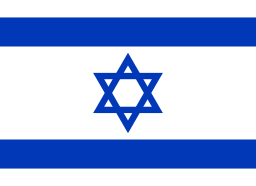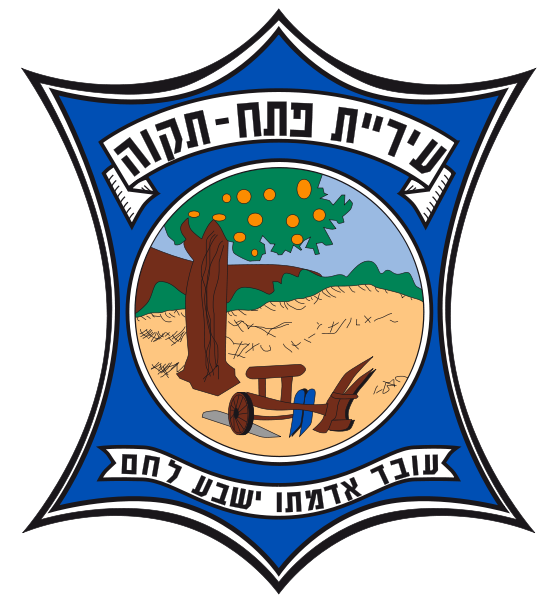
פּתח תּקוה Coordinates: 32° 05' 19.78" N 34° 53' 10.80" E 
|
||

פּתח תּקוה Coordinates: 32° 05' 19.78" N 34° 53' 10.80" E 
|
||
| Home | Maps | The Fallen | Links | Census |

Petah Tikva1,7 ('The Door of Hope') is also known as Em HaMoshavot ('Mother of the Moshavot'). The former town name was chosen by the settlement's founders in 1878; it is derived from the prophecy of Hosea (2:15, 2:17). Petah Tikva's coat of arms contains three elements. The plow represents the settlement's agricultual purpose. The field reflects the draining of the Yarkon River swamp and its conversion into arable land. And the orange tree is symbolic of the moshava's orange industry. The coat of arms is inscribed with a verse from Proverbs (12:11) – 'He who works his land will have abundant bread'.
European religious pioneers founded Petah Tikva in 18786. It was the first modern Jewish agricultural settlement located in Ottoman Southern Syria. Prior to the establishment of Petah Tikva, the pioneers had attempted to purchase land in the Achor Valley near Jericho, but Sultan Abdülhamid II forbade the purchase2. However, in 1878 the sultan permitted the purchase of land northeast of Jaffa because of its poor quality, much of it malarial swamp in the Yarkon Valley. Two years after the land purchase, a malaria epidemic broke out that forced the settlers to abandon their property. In 1883 Petah Tikva was reoccupied after Baron Edmond de Rothschild provided funds for draining the swamp.
The First World War saw the British fighting the Ottoman Army in the Middle East during the Sinai and Palestine Campaign3. Petah Tikva became a refuge for Jews who were expelled from both Tel Aviv and Jaffa by the Ottoman government. The town was caught between the battle lines of the two adversaries; by the end of the war Petah Tikva was severely damaged.
The post-war period saw significant growth in Petah Tikva, including the introduction of industry. There were problems along the way, such as the 1921 Arab Riots4,5 that resulted in the murder of several Jews. The British Mandate Census of 1922 recorded 3,008 Jews living in Petah Tikva; by 1931 this population increased by 123.7%, to 6,729 Jewish residents (see Census Tab for details). In 1937, the town was large enough to be declared a city; its first mayor, Shlomo Stampfer, was the son of Yehoshua Stampfer, a founder of Petah Tikva. Prior to the election of Petah Tikva's first mayor, beginning in 1880, the village was governed by an elected council of seven people.
The electrification of Petah Tikva was first conceived of in 1921. The settlement's agricultural efforts were devoted to citrus fruits which, because of the moshava's size, depended on electricity for efficient irrigation. The Jaffa Electric Company was given the concession, but its irrigation plans did not receive British Government approval until 1930.
The founders of Kibbutz Yavneh8, who belonged to the Religious Zionist9 movement, settled near Petah Tikva in the 1930s. Improving on the farming skills that they learned in Germany, in 1941 they began to build their kibbutz in the south of Israel, using Petah Tikva as a base.
After 1948, Petah Tikva's geographic extent and population size took 'giant leaps' when several nearby villages were incorporated into Petah Tikva's borders. The population suddenly attained 22,000 people; today, the number of residents exceeds two-hundred-thousand. The city has grown to be Israel's second-largest industrial sector that include textiles, metalwork, plastics, food-processing and high-tech companies.
Petah Tikva contains several hundred schools, extending through high school; these schools cover secular, religious, and Haredi10 educational philosophies, teaching more than 43,000 students. There are three-hundred synagogues, eight mikvaot, and two Haredi yeshivot.
There are six hospitals located in the city. These include the Rabin Medical Center Beilinson complex, the Beit Rivka Geriatric Center, the Kupat Holim Medical Research Center, and the Schneider Pediatric Center, one of the most modern children's hospitals in the Middle East.
The Second Intifada11 reached Petah Tikva three times, two suicide bombing incidents and a knife attack. Eight people died in these attacks, including a baby.
A number of notable residents are connected to Petah Tikva. Among these are:
|
Please contact Leah Haber Gedalia with your additions, questions, corrections, or comments! webmaster: richard L. baum |
|
This page is hosted at no cost to the public by JewishGen, Inc., a non-profit corporation. If it has been useful to you, or if you are moved by the effort to preserve the memory of our lost communities, your JewishGen-erosity would be deeply appreciated. |
|
KehilaLinks Home |
JewishGen Home
|
Created: 12 Mar 2018
Last Modified: 05-28-2018
Copyright © 2018 Leah Gedalia
All Rights Reserved.